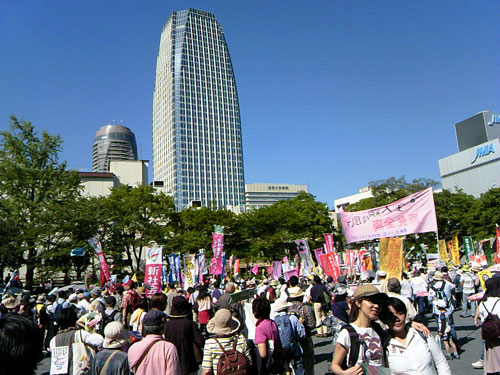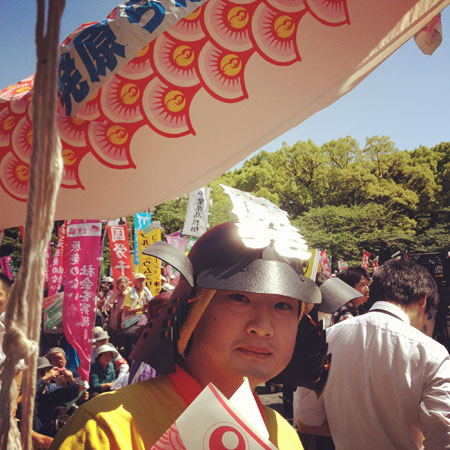Prior to the government explanation, Shiga and Kyoto Prefectures submitted a seven-point proposal to the government on April 17 in which they demanded the early establishment of the Nuclear Regulatory Agency and a roadmap indicating a phase-out of reliance on nuclear power, showing that 'understanding' was still quite some way off. Further, on April 10, Osaka Prefecture and Osaka City, one step further away from Fukui Prefecture, announced eight conditions, including the conclusion of safety agreements with local administrations within 100 km of nuclear power plants, which was submitted to the government on April 24. Fukui Prefecture had already, on September 15, 2011, demanded that the government strengthen disaster prevention measures such as the early construction or improvement of roads for disaster control, as well as making restarts conditional on such matters as the public announcement of all information concerning the Fukushima nuclear accident. Opinion polls conducted by mass media companies also showed that opposition to restarts was running strong and that the hurdles to nuclear reactor restarts are, in fact, very high. In spite of this, it is not easy to predict how long restarts can be prevented. The most important thing is to prevent restarts from occurring for as long as possible and show for a fact that there is no non-nuclear power supply shortage problem in Japan, even in overcoming the summer peak power demand. It is undoubtedly for this reason that the government and the power industry want to restart as many nuclear reactors as possible in order to be able to say that we were spared blackouts thanks to nuclear power. Concerning power supply, the government and the power industry are disseminating the propaganda that if nuclear reactors remain shut down demand will exceed supply, especially in KEPCO's generating region. However, with regard to KEPCO's estimated power demand, several experts have pointed out that KEPCO has underestimated both its supply estimates and the effect of power saving compared with other power companies, and that power supply compatible with demand is possible by purchase of power from other suppliers. In any event, the implied notion that "power supply is more important than safety" is mistaken. Even though that may be so, over and above that, and with the background of the proof that there is no non-nuclear power supply shortage problem, we would like to bring about a phase-out of nuclear power through clear enshrinement in laws as the policy of the state and/or as the firm decision of the power companies. While a nuclear phase-out may be fraught with difficulties, it is not always clear exactly what those difficulties are. Once the country is determined to implement a nuclear phase-out policy, the difficulties will then become clear in a much more concrete form. It is, indeed, only in this way that appropriate countermeasures can be set up. The government has said that it will initiate a national public discussion on energy policy. The new energy policy, entitled the "Innovative Energy and Environmental Strategy" is due to be finalized sometime this summer. Formulation of the "Strategy" is to be coordinated by an "Energy and Environment Council" consisting of the Minister for National Strategy as chairperson, and the Ministers of Economy, Trade and Industry; Education, Culture, Sports, Science and Technology; and the Minister for the Restoration from and Prevention of Nuclear Accidents. It is said that the "Strategy" will reflect discussions on a review of the Framework for Nuclear Energy Policy and the Basic Energy Plan. The Framework for Nuclear Energy Policy is a document drawn up and approved by the Atomic Energy Commission, and the task of drawing up a revised version began in late 2010. The Basic Energy Plan is drawn up by the Advisory Committee for Natural Resources and Energy, a consultative body of the Minister for Economy, Trade and Industry, is approved by cabinet decision and takes the form of policy drawn up by the government. The Plan was revised recently, in 2010, and since it has a very strong bias towards the promotion of nuclear power, following the Fukushima nuclear power plant earthquake disaster it is due to be reviewed "from scratch." The review of the Basic Energy Plan will indicate options for the composition of power supply from different sources (nuclear power, thermal, renewables, etc.), and the revision of the Framework for Nuclear Energy Policy will show options for the nuclear fuel cycle (reprocessing of all used fuel, direct disposal, and storage), data such as costs and CO2 emissions being given for each of these options. The options for the new energy policy will then be the subject of national discussion. The options themselves look as if they will present problems, since the effect of energy conservation and other efforts are likely to be underestimated for each of the options, leading to a higher estimate for total power demand. CNIC's Hideyuki Ban is participating as a committee member in both reviews and is struggling to ensure that at least some meaningful options are taken up. In the end, however, it is crucial that it is the people of the nation who decide energy policy and that the solicitation of opinions does not become a mere exercise in formality. (Baku Nishio, CNIC Co-Director) see CNIC's statement: Toward a New Era in which the people Choose the Energy (5 May, 2012) Return to CNIC's Earthquakes and Nuclear Power page Return to Nuclear Policy index page Return to NIT 148contents |

| CNIC Citizens' Nuclear Information Center Akebonobashi Co-op 2F-B, 8-5 Sumiyoshi-cho, Shinjuku-ku, Tokyo, 162-0065, Japan TEL.03-3357-3800 FAX.03-3357-3801 Map http://cnic.jp/english/ |

 May 5 is "Children's Day" in Japan, a holiday on which the happiness of children is celebrated. On this day in 2012, the children received the special gift of the total shutdown of all Japan's nuclear power plants. The one reactor that was online, Hokkaido Electric Power Company's Tomari Unit 3 (PWR, 912MW) was halted for regular maintenance.
May 5 is "Children's Day" in Japan, a holiday on which the happiness of children is celebrated. On this day in 2012, the children received the special gift of the total shutdown of all Japan's nuclear power plants. The one reactor that was online, Hokkaido Electric Power Company's Tomari Unit 3 (PWR, 912MW) was halted for regular maintenance.